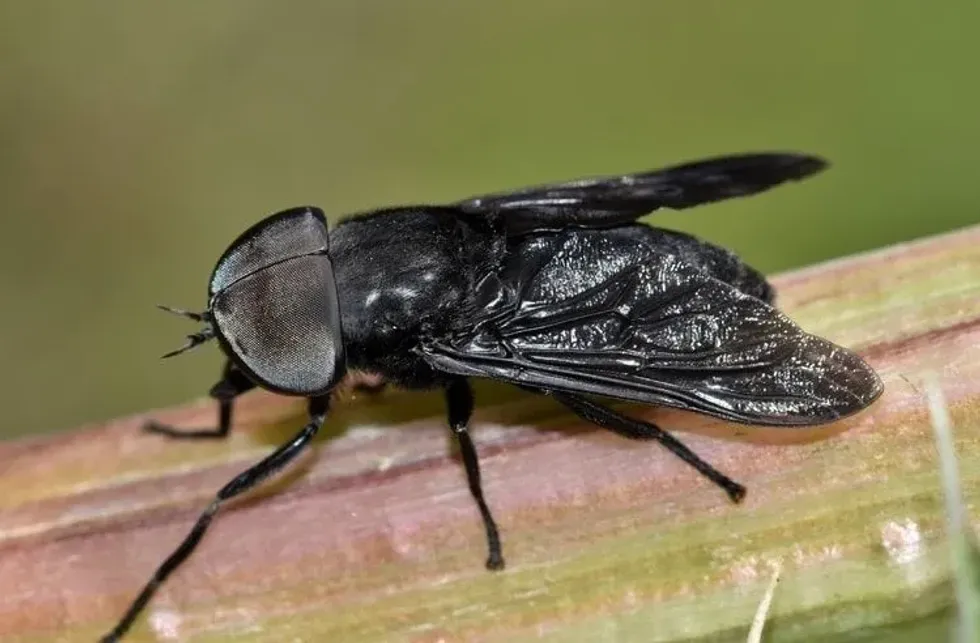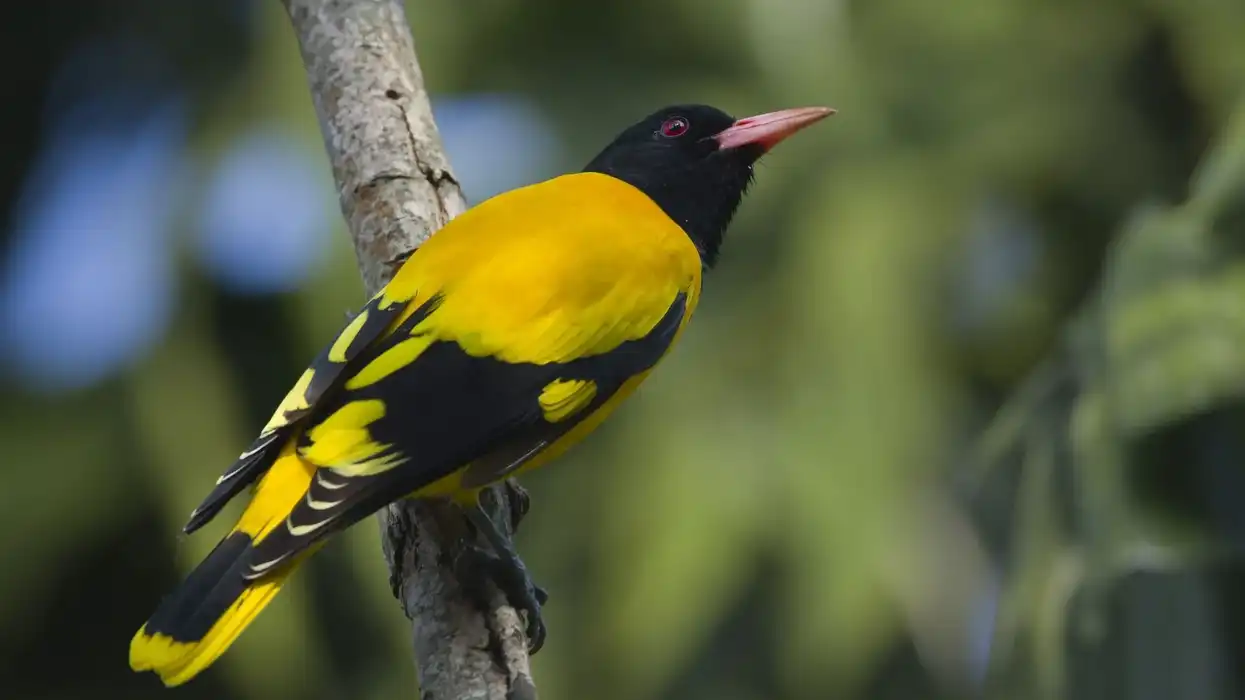The black horse-fly (Tabanus atratus) is a species of the biting genus of housefly Tabanus and family Tabanidae. The generic name Tabanus was first ever recorded by Pliny the Younger. This fly belongs to the Tabanini tribe and subfamily Tabanidae.
Tabanini consists of 220 officially describe species of horse and deer flies. There are seven genera under this tribe.
The subfamily Tabaninae has over 3000 described horse-fly species. These flies of Tabaninae lack spurs on the tips of hind tibiae and ocelli. These horse-flies spread anthrax, trypanosomes, and worms.
The mouthparts of female horse-flies have a scissor-like opening, and the females feed on the blood of the horses for which these species are named horse-flies. The horse-flies are given various names in various places.
They are referred to as march flies in the United Kingdom and Australia. They are called breeze-flies or horse-flies in North America. As the name suggests, the black horse-fly is entirely black in color and not too harmful to humans.
If you like these facts about the black horse-fly, please do read about other animals like the regal moth and gypsy moth.
Black Horse-Fly Interesting Facts
What type of animal is a black horse-fly?
The black horse-fly (Tabanus atratus) is a biting fly of the order Diptera and phylum Arthropoda. The horse-fly is considered a biting pest near livestock or cattle. They are also a great threat to the livestock.
Even though they are large they can fly fast. The males neither bite nor do they seek blood meal but only feed on nectar. They are active in the day and feed ruthlessly from their host's body.
These horse-flies rest on roads and paths mainly in wooded areas. Less population of lies occupy areas when the temperature drops or wind picks up. They are also attracted to light sources at night.
What class of animal does a black horse-fly belong to?
The black horse-fly (Tabanus atratus) belongs to Insecta class of animals.
How many black horse-flies are there in the world?
The exact number of the black horse-fly (Tabanus atratus) is not known. The fly population is a major success in the insect world. The Tabanus genus has around 1,300 species spread across the world.
Where does a black horse-fly live?
The range of habitat of the black horse-fly is across the eastern United States and is endemic to North America.
What is a black horse-fly's habitat?
The black horse-fly's range of habitat includes a variety of regions. However, they cannot stay alive in extreme climates like the desert or mountain top. You can find them in habitats where they can find mammals to feed on and to lay eggs.
Who does black horse-fly live with?
The black horse-fly lives on its own.
How long does a black horse-fly live?
The life cycle of this fly includes a year of transforming from water larvae, pupae, and adults for a year. The adult horse-fly lives only for 30-60 days.
How do they reproduce?
The black horse-fly needs an aquatic environment for reproduction, eggs, and water larvae. Reproduction takes place when the adults emerge. Then male horse-flies feed on nectar, and female horse-flies search for a blood meal.
The female lays three to four masses of 100-1,000 eggs near the edge of a water surface or near a water surface. The female searches for an appropriate moist environment to lay her eggs. No further care is provided by females.
The life cycle of this fly involves eggs, horse-fly larvae, pupa, and adults. The horse-fly larvae will either drop into the water or burrow in a moist surrounding.
and before completion of population, they mature through six to nine instars. The larvae first overwinter in colder regions and move into dry soil to pupate. They stay in a pupal stage for one or three weeks.
What is their conservation status?
The conservation status of the horse-flies or deer flies is Not Evaluated.
Black Horse-Fly Fun Facts
What do black horse-flies look like?
The body of the adult horse-flies is either completely black, blackish-purple, or dark brown. The adult horse-flies have large and compound eyes that are continuous or holoptic in males and separated or dichoptic females. The antennae are short and horn-shaped.
The distinct mouthparts have a fascicle that has six organs. They have two blade-like and flattened mandibles that have tooth-like serrations, which they use for cutting.
They also have two narrow and serrated maxillae that are capable of tissues and blood vessels of their hosts. These two maxillae are the median labrum epipharynx and median hypopharynx. These make up their food canal, and the labrum allows them to drink blood.
They have pronounced wings venation and the body is covered in short, stout hair. The larvae are similar to all the other larvae species of a horse-fly.
The slender and cylindrical larvae are white to tan-colored. There are two sharp mandibles on the retractable head of the larvae that can cause painful bites. Some of them have transparent wings, and others have black wings.

How cute are they?
The horse-flies, like the deer flies, are not considered cute.
How do they communicate?
Like all other flies, they communicate through vocalization, visualization, and producing pheromones.
How big is a black horse-fly?
The length range of an adult horse-fly is 1 in (26 mm). The horse-flies are as large as a bumblebee and as small as a housefly as per their length. They are also smaller than deer flies.
How fast can a black horse-fly fly?
They fly very fast for their size. The fastest ever recorded flight speed of this fly is 90 mph (145 kph).
How much does a black horse-fly weigh?
The exact weight of these horse-flies is not known. The average weight of a horse-fly is 0.00002 lb (12 mg)
What are the male and female names of the species?
There is no specific name given to the female and male black horse-fly.
What would you call a baby?
There is no specific name given to the baby horse-fly. The aquatic larvae are usually referred to as horse-fly larvae.
What do they eat?
The adult female insects drink the blood of mammals whereas males only feed on plant juices and nectar. The females feed on blood to develop the eggs. Like their relatives, mosquitos, males are vegetarian.
There are six piercing organs on the mouthparts: two maxillae, two mandibles, a labryn epipharynx, and a hypopharynx. The females are usually attracted to CO2 and large and dark moving objects when she is looking for food. The larvae feed on other insect larvae, small vertebrates, and other invertebrates.
Are they poisonous?
No, the adult insects are not poisonous and the bites are not harmful to humans. The bite has effects only on horses.
Would they make a good pet?
No. These insects would not make a good pet. The life span of these pest species is small, and they can harm livestock. They are not dangerous to human beings and their bite does not kill. If a horse-fly bites you, there will be momentary pain but you will not be infected.
Did you know...
The Tabanidae fly or pest family can spread disease on the victims that they bite, which is mostly livestock. The serious issues faced by livestock when they are used in beef and milk production industries and grazing.
Various species of birds feed on these insects, warbler birds like palm warbler and pine warbler and wasps like the horse guard wasp.
Both horse and deer flies are persistent pests, biters, and strong flies. They can also spread anthrax, trypanosomes, and worms.
There have been records on horse-flies doing Immelman turns similar to fighter jets.
What is a giant black fly?
A giant black fly is a big black horse-fly that leaves painful bites and sores on its victims. Its hosts are livestock, cattle, and humans and are considered as a pest.
Why are horse-flies so aggressive?
Horse-flies are aggressive because they are hungry or their babies are. The female bites and drinks blood to get protein from the blood and to grow their eggs. They also need more blood than mosquitos.
Here at Kidadl, we have carefully created lots of interesting family-friendly animal facts for everyone to discover! Learn more about some other arthropods from our tan jumping spider facts or pirate spider facts pages.
You can even occupy yourself at home by drawing one on our Black Horse Fly coloring pages.










